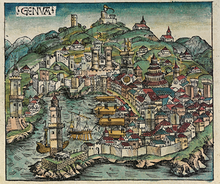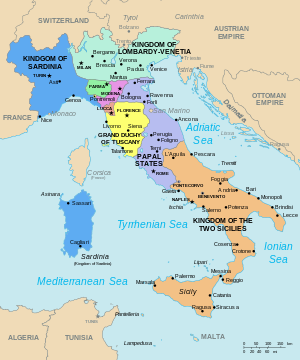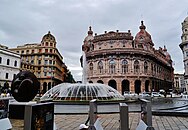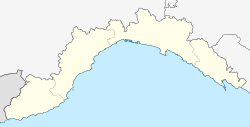
A | B | C | D | E | F | G | H | CH | I | J | K | L | M | N | O | P | Q | R | S | T | U | V | W | X | Y | Z | 0 | 1 | 2 | 3 | 4 | 5 | 6 | 7 | 8 | 9
Genoa
| |
|---|---|
| Comune di Genova | |
Skyline of Genoa XX Settembre street | |
|
| |
| Coordinates: 44°24′40″N 8°55′58″E / 44.41111°N 8.93278°E | |
| Country | Italy |
| Region | Liguria |
| Metropolitan city | Genoa (GE) |
| Government | |
| • Mayor | Marco Bucci |
| Area | |
| • Total | 240.29 km2 (92.78 sq mi) |
| Elevation | 20 m (70 ft) |
| Population (1 January 2018)[2] | |
| • Total | 580,097 |
| • Density | 2,400/km2 (6,300/sq mi) |
| Demonym(s) | Genoese, Genovese |
| Time zone | UTC+1 (CET) |
| • Summer (DST) | UTC+2 (CEST) |
| Postal code | 16121-16167 |
| Dialing code | 010 |
| ISTAT code | 010025 |
| Patron saint | John the Baptist |
| Saint day | 24 June |
| Website | comune |
| Official name | Genoa: Le Strade Nuove and the system of the Palazzi dei Rolli |
| Criteria | Cultural: (ii)(iv) |
| Reference | 1211 |
| Inscription | 2006 (30th Session) |
| Area | 15.777 ha (38.99 acres) |
| Buffer zone | 113 ha (280 acres) |
Genoa (/ˈdʒɛnoʊə/ JEN-oh-ə, Italian: Genova, Italian: [ˈdʒɛːnova] ; Ligurian: Zêna, Ligurian: [ˈzeːna])[a] is a city in and the capital of the Italian region of Liguria, and the sixth-largest city in Italy. In 2023, 558,745 people lived within the city's administrative limits.[3] While its metropolitan city has 813,626 inhabitants,[3] more than 1.5 million people live in the wider metropolitan area stretching along the Italian Riviera.[4]
On the Gulf of Genoa in the Ligurian Sea, Genoa has historically been one of the most important ports on the Mediterranean: it is currently the busiest in Italy and in the Mediterranean Sea and twelfth-busiest in the European Union.[5][6]
Genoa was the capital of one of the most powerful maritime republics for over seven centuries, from the 11th century to 1797.[7] Particularly from the 12th century to the 15th century, the city played a leading role in the commercial trade in Europe, becoming one of the largest naval powers of the continent and considered among the wealthiest cities in the world.[8][9] It was also nicknamed la Superba ("the proud one") by Petrarch due to its glories on the seas and impressive landmarks.[10] The city has hosted massive shipyards and steelworks since the 19th century, and its solid financial sector dates back to the Middle Ages. The Bank of Saint George, founded in 1407, is the oldest known state deposit bank in the world and has played an important role in the city's prosperity since the middle of the 15th century.[11][12]
The historical centre, also known as old town, of Genoa is one of the largest and most-densely populated in Europe.[13] Part of it was also inscribed on the World Heritage List (UNESCO) in 2006 as Genoa: Le Strade Nuove and the system of the Palazzi dei Rolli. Genoa's historical city centre is also known for its narrow lanes and streets that the locals call "caruggi".[14] Genoa is also home to the University of Genoa, which has a history going back to the 15th century, when it was known as Genuense Athenaeum. The city's rich cultural history in art, music and cuisine allowed it to become the 2004 European Capital of Culture. It is the birthplace of Guglielmo Embriaco, Christopher Columbus, Andrea Doria, Niccolò Paganini, Giuseppe Mazzini, Renzo Piano and Grimaldo Canella, founder of the House of Grimaldi, among others.
Genoa, which forms the southern corner of the Milan-Turin-Genoa industrial triangle of Northwest Italy, is one of the country's major economic centers.[15][16] A number of leading Italian companies are based in the city, including Fincantieri, Leonardo,[17] Ansaldo Energia,[18] Ansaldo STS, Erg, Piaggio Aerospace, Mediterranean Shipping Company and Costa Cruises.
Name
The city's modern name may derive from the Latin word meaning "knee" (genu; plural, genua) but there are other theories. It could derive from the god Janus, because Genoa, like him, has two faces: a face that looks at the sea and another turned to the mountains. Or it could come from the Latin word ianua, also related to the name of the God Janus, and meaning "door", or "passage." Besides that, it may refer to its geographical position at the centre of the Ligurian coastal arch. The Latin name, oppidum Genua, is recorded by Pliny the Elder (Nat. Hist. 3.48) as part of the Augustean Regio IX Liguria.[19]
Another theory traces the name to the Etruscan word Kainua which means "New City", based on an inscription on a pottery sherd reading Kainua, which suggests that the Latin name may be a corruption of an older Etruscan one with an original meaning of "new town".[20]
History
Prehistory and Roman times
The city's area has been inhabited since the fifth or fourth millennium BC, making it one of the oldest continuously inhabited cities in the world.[21] In the fifth century BC the first town, or oppidum, was founded probably by the ancient Ligures (which gave the name to the modern region of Liguria) at the top of the hill today called Castello (Castle), which is now inside the medieval old town.[22][23] In this period the Genoese town, inhabited by the "Genuati" (a group of Ligure peoples), was considered "the emporium of the Ligurians", given its strong commercial character.[24]
The "Genoese oppidum" had an alliance with Rome through a foedus aequum (equal pact) in the course of the Second Punic War. The Carthaginians accordingly destroyed it in 209 BC. The town was rebuilt and, after the Carthaginian Wars ended in 146 BC, it received municipal rights. The original castrum then expanded towards the current areas of Santa Maria di Castello and the San Lorenzo promontory. Trade goods included skins, timber, and honey. Goods were moved to and from Genoa's hinterland, including major cities like Tortona and Piacenza. An amphitheater was also found there among other archaeological remains from the Roman period.[25]
Middle Ages to early modern period
5th to 10th centuries
After the fall of the Western Roman Empire, the Ostrogoths occupied Genoa. After the Gothic War, the Byzantines made it the seat of their vicar. When the Lombards invaded Italy in 568, Bishop Honoratus of Milan fled and held his seat in Genoa.[26] During this time and in the following century Genoa was little more than a small centre, slowly building its merchant fleet, which was to become the leading commercial carrier of the Western Mediterranean. In 934–35 the town was thoroughly sacked and burned by a Fatimid fleet under Ya'qub ibn Ishaq al-Tamimi.[27]
Rise of the Genoese Republic



Genoa started expanding during the First Crusade. At the time the city had a population of about 10,000. Twelve galleys, one ship and 1,200 soldiers from Genoa joined the crusade. The Genoese troops, led by noblemen de Insula and Avvocato, set sail in July 1097.[28] The Genoese fleet transported and provided naval support to the crusaders, mainly during the siege of Antioch in 1098, when the Genoese fleet blockaded the city while the troops provided support during the siege.[28] In the siege of Jerusalem in 1099 Genoese crossbowmen led by Guglielmo Embriaco acted as support units against the defenders of the city.
The Republic's role as a maritime power in the Mediterranean region secured many favorable commercial treaties for Genoese merchants. They came to control a large portion of the trade of the Byzantine Empire, Tripoli (Libya), the Principality of Antioch, Cilician Armenia, and Egypt.[28] Although Genoa maintained free-trading rights in Egypt and Syria, it lost some of its territorial possessions after Saladin's campaigns in those areas in the late 12th century.[29][30]
13th and 14th centuries
The commercial and cultural rivalry of Genoa and Venice was played out through the thirteenth century. Thanks to the major role played by the Republic of Venice in the Fourth Crusade, Venetian trading rights were enforced in the eastern Mediterranean and Venice was able to gain control of a large portion of maritime commerce in the region.[29]
To regain control of local commerce, the Republic of Genoa allied with Michael VIII Palaiologos, emperor of Nicaea, who wanted to restore the Byzantine Empire by recapturing Constantinople. In March 1261 the treaty of the alliance was signed in Nymphaeum.[29] On 25 July 1261, Nicaean troops under Alexios Strategopoulos recaptured Constantinople.[29] As a result, the balance of favour tipped toward Genoa, which was granted free trade rights in the Nicene Empire.[29] The islands of Chios and Lesbos became commercial stations of Genoa as well as the city of Smyrna (Izmir). In the same century the Republic conquered many settlements in Crimea, known as Gazaria, where the Genoese colony of Caffa was established. The alliance with the restored Byzantine Empire increased the wealth and power of Genoa, and simultaneously decreased Venetian and Pisan commerce. The Byzantine Empire had granted the majority of free trading rights to Genoa.[31]
Around the 14th century, Genoa was also credited with the invention of blue jeans. Genoa's jean fabric was a fustian textile of "medium quality and of reasonable cost", very similar to cotton corduroy for which Genoa was famous, and was "used for work clothes in general". The Genoese navy equipped its sailors with jeans, as they needed a fabric which could be worn wet or dry.[32][33]
As a result of the Genoese support to the Aragonese rule in Sicily, Genoa was granted free trading and export rights in the Kingdom. Genoese bankers also profited from loans to the new nobility of Sicily. Corsica was formally annexed in 1347.[34]
15th and 16th centuries



In the 15th century two of the earliest banks in the world were founded in Genoa: the Bank of Saint George, founded in 1407, which was the oldest state deposit bank in the world at its closure in 1805 and the Banca Carige, founded in 1483 as a mount of piety, which still exists. Christopher Columbus was born in Genoa c. 1451, and donated one-tenth of his income from the discovery of the Americas for Spain to the Bank of Saint George in Genoa for the relief of taxation on foods. Under the ensuing economic recovery, many aristocratic Genoese families, such as the Balbi, Doria, Grimaldi, Pallavicini, and Serra, amassed tremendous fortunes. According to Felipe Fernandez-Armesto and others, the practices Genoa developed in the Mediterranean (such as chattel slavery) were crucial in the exploration and exploitation of the New World.[35]
Thereafter, Genoa underwent something of an associate of the Spanish Empire, with Genoese bankers, in particular, financing many of the Spanish crown's foreign endeavors from their counting houses in Seville. Fernand Braudel has even called the period 1557 to 1627 the "age of the Genoese", "of a rule that was so discreet and sophisticated that historians for a long time failed to notice it" (Braudel 1984 p. 157). The Genoese bankers provided the unwieldy Habsburg system with fluid credit and a dependably regular income. In return the less dependable shipments of American silver were rapidly transferred from Seville to Genoa, to provide capital for further ventures. Genoa's trade, however, remained closely dependent on control of Mediterranean sealanes, and the loss of Chios to the Ottoman Empire (1566), struck a severe blow.[36] To help cope, Panama in the Americas was given as concession from the Spanish Empire to Genoa.[37] The Genoese there encountered coconuts from the Philippines planted there by Malay seafarers before Spain came.[38] The Spanish governor of Panama, Don Sebastian Hurtado de Corcuera sailed west from the Americas and used Peruvians, and Genoese from Panama in his conquest of Muslim areas of the Philippines which he subjugated to the Christian Presidio of Zamboanga.[39] Curiously, Zamboanga's Chavacano Creole language, has Italian vocabulary and cognates.[40]
17th century

From the 17th century, the Genoese Republic started a period of slow decline, In May 1625 a French-Savoian army briefly laid siege to Genoa. Though it was eventually lifted with the aid of the Spanish, the French would later bombard the city in May 1684 for its support of Spain during the War of the Reunions.[41] In-between, a plague killed as many as half of the inhabitants of Genoa in 1656–57.[42]
18th century
In 1729, the Republic of Genoa must cope with the beginning of the Corsica revolution for the independence, first led by Luiggi Giafferi and Giacinto Paoli, which culminated after 26 years of struggles, costly in economic and military terms for the Republic of Genoa, in a self proclaimed Corsican Republic in 1755 under the leadership of Pasquale Paoli, son of Giacinto Paoli.
The Republic of Genoa continued its slow decline well into the 18th century, losing its last Mediterranean colony, the island fortress of Tabarka, to the Bey of Tunis in 1742.[43]
The Convention of Turin of 1742, in which Austria allied with the Kingdom of Sardinia, caused some consternation in the Republic. Consequently, the Republic of Genoa signed a secret treaty with the Bourbon allies of Kingdom of France, Spanish Empire and Kingdom of Naples. On 26 June 1745, the Republic of Genoa declared war on the Kingdom of Sardinia. This decision would prove disastrous for Genoa, which later surrendered to the Austrians in September 1746 and was briefly occupied before a revolt liberated the city two months later.[44]

The Republic of Genoa, in a weak state and not capable of suppressing the Corsican struggle for independence, was forced to cede Corsica to France in 1768 Treaty of Versailles. Only a year later, Napoleon Bonaparte was born in Corsica.
In 1780, the Confetteria Romanengo was founded in Genoa.[45]
The fall of the Republic
The direct intervention of Napoleon (during the Campaigns of 1796) and his representatives in Genoa was the final act that led to the fall of the Republic in early June, who overthrew the old elites which had ruled the state for all of its history, giving birth to the Ligurian Republic on 14 June 1797, under the watchful care of Napoleonic France.
19th century
After Bonaparte's seizure of power in France, a more conservative constitution was enacted, but the Ligurian Republic's life was short—in 1805 it was annexed by France, becoming the départements of Apennins, Gênes, and Montenotte.[46]
The annexation to the Kingdom of Sardinia

Following the fall of Napoleon, Genoa regained ephemeral independence, with the name of the Repubblica genovese, which lasted less than a year. However, the Congress of Vienna established the annexation of the whole territories of the former Genoese Republic to the Kingdom of Sardinia, governed by the House of Savoy, contravening the principle of restoring the legitimate governments and monarchies of the old Republic.[47]
Italian Risorgimento


In the 19th century, Genoa consolidated its role as a major seaport and an important steel and shipbuilding centre. In Genoa in 1853, Giovanni Ansaldo founded Gio. Ansaldo & C. whose shipyards would build some of the most beautiful ships in the world, such as ARA Garibaldi, SS Roma, MS Augustus, SS Rex, SS Andrea Doria, SS Cristoforo Colombo, MS Gripsholm, SS Leonardo da Vinci, SS Michelangelo, and SS SeaBreeze. In 1854, the ferry company Costa Crociere was founded. In 1861 the Registro Italiano Navale Italian register of shipping was created, and in 1879 the Yacht Club Italiano. The owner Raffaele Rubattino in 1881 was among the founders of the ferry company Navigazione Generale Italiana which then become the Italian Line.[48] In 1870 Banca di Genova was founded which in 1895 changed its name to Credito Italiano and in 1998 became Unicredit. In 1874 the city was completely connected by railway lines to France and the rest of Italy: Genoa-Turin, Genoa-Ventimiglia, Genoa-Pisa. In 1884 Rinaldo Piaggio founded Piaggio & C. that produced locomotives and railway carriages and then in 1923 began aircraft production. In 1888 the Banca Passadore was established. In 1898 the insurance company called Alleanza Assicurazioni was founded.
Zdroj:https://en.wikipedia.org?pojem=Genoa,_ItalyText je dostupný za podmienok Creative Commons Attribution/Share-Alike License 3.0 Unported; prípadne za ďalších podmienok. Podrobnejšie informácie nájdete na stránke Podmienky použitia.
Antropológia
Aplikované vedy
Bibliometria
Dejiny vedy
Encyklopédie
Filozofia vedy
Forenzné vedy
Humanitné vedy
Knižničná veda
Kryogenika
Kryptológia
Kulturológia
Literárna veda
Medzidisciplinárne oblasti
Metódy kvantitatívnej analýzy
Metavedy
Metodika
Text je dostupný za podmienok Creative
Commons Attribution/Share-Alike License 3.0 Unported; prípadne za ďalších
podmienok.
Podrobnejšie informácie nájdete na stránke Podmienky
použitia.
www.astronomia.sk | www.biologia.sk | www.botanika.sk | www.dejiny.sk | www.economy.sk | www.elektrotechnika.sk | www.estetika.sk | www.farmakologia.sk | www.filozofia.sk | Fyzika | www.futurologia.sk | www.genetika.sk | www.chemia.sk | www.lingvistika.sk | www.politologia.sk | www.psychologia.sk | www.sexuologia.sk | www.sociologia.sk | www.veda.sk I www.zoologia.sk













